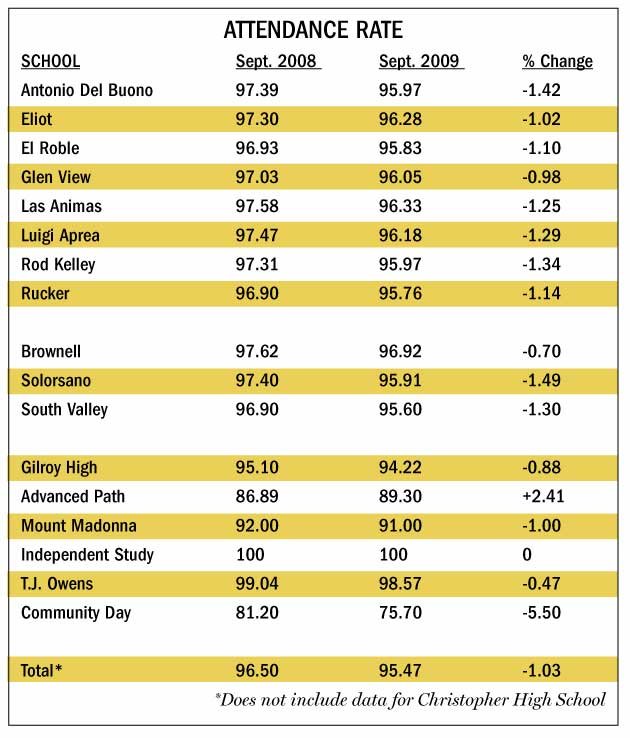Influenza and swine flu sent home an additional 98 students per
day last month, causing the school district’s attendance rate to
plummet and costing it about $76,000.
Influenza and swine flu sent home an additional 98 students per day last month, causing the school district’s attendance rate to plummet and costing it about $76,000.
Every day in September, the district sent hundreds of students home with flu or swine flu and urged them to stay there until they recovered. The district’s caution, however, came with a price. Students in their seats translates to money for the district – $35.37 per student per day, according to Director of Fiscal Services Kirsten Saling. If the district’s average daily percentage dips by a percentage point – the equivalent of about 100 students not going to class – the district loses more than $600,000 over the course of a year, said Deputy Superintendent of Business Services Enrique Palacios.
“Average daily attendance is our bread and butter,” Palacios said.
In September 2009, the district averaged about 460 absences – about 100 higher than last year – according to district numbers. This translates to about $3,500 per day in lost revenue, and with 22 school days in September, this meant more than $76,000 – or two employees’ compensation – that the school district would have earned had it not been for the increased absenteeism.
Some schools – such as Ascencion Solorsano Middle, Antonio Del Buono Elementary and Rod Kelley Elementary schools – were hit particularly hard while others were relatively untouched. Ninety students called in sick at Solorsano – a school of 1,100 – on one day alone, Gilroy Unified School District Superintendent Deborah Flores said.
“At Solorsano, we lost more than $3,000 in one day,” Flores said. “That’s significant.”
Rucker Elementary, Luigi Aprea Elementary and South Valley Middle schools also experienced significant drops in September attendance compared to August. Large or small, every school in the district saw more absenteeism in September 2009 compared to August 2009 and September 2008.
“This is an unusual year where we have this much illness this early,” Flores said.
According to the district’s historical data, the attendance rate typically starts off strong – around 97 percent – in August then tumbles to the low 90s in January just after the holidays and at the peak of flu season. Attendance rates usually rebound in the spring, but not to the level seen at the beginning of the school year.
The upper grades also experience a drop-off toward the end of the school year, district numbers show. In the 2007-08 school year, the district’s average daily attendance was 93.34 percent. In 2008-09, it was 95.39.
District officials were originally under the impression that the district would not lose money for excused absences. But that policy changed about 10 years ago, Flores clarified, and the district does, in fact, lose money whether an absence is excused or not.
“Basically, there’s no such thing as excused absences now,” Flores said.
Attendance is a “top priority” this school year, Flores said, adding that she expected the school board to make it one of their goals and school sites to provide incentives for coming to school. Even scheduling a doctor’s appointment or family event on the weekend or later in the weekday could make a different, Flores said.
“I don’t think some families understand that we only receive (average daily attendance funding) for students who are in school,” she said. “We are trying to make those connections to the entire school community. If we had a one percent increase, that would represent more than $500,000. It’s a huge amount of money we’re losing. The higher we get our percentage up, the more revenue we receive.”
Though the state grants exceptions in certain types of emergencies – such as fire, flood and transportation strikes – the district is uncertain whether it will be able to recoup the lost revenue from the state. Either way, the district will apply for a wavier for the recent spate of illness, and for one day last school year when the district closed Rucker Elementary School due to several possible cases of swine flu.
“We’ve got nothing to lose,” said Flores, who fell victim to the flu herself earlier this year.
The debate over whether schools should receive funds for excused absences is controversial and many educators and parents believe excused absences should not cost the district revenue, Flores said.
Even if GUSD appeals to the California Department of Education, the district might be “out of luck,” said Hilary McLean, communications director with the CDE.
“This has been an interesting process for us all to rethink our message to kids,” she said. “Our message is always to come to school. But we need to encourage parents to keep their children home when they’re sick. We realize that certainly does pose a challenge for the workforce and students.”
According to a statement issued by the state department of education, it will take a closer look at the impact of the flu on schools upon “resumption of normal business at the conclusion of the pandemic.”















